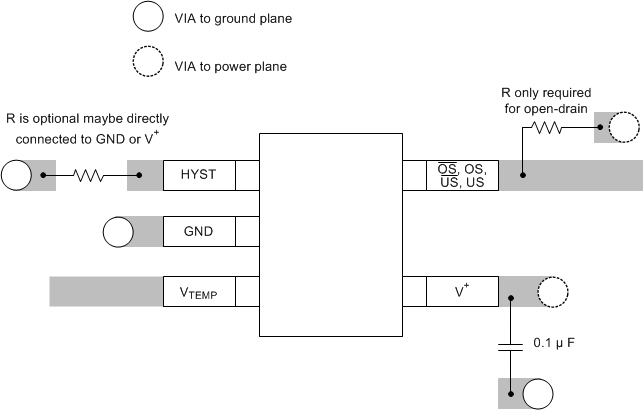SNIS115S May 2001 – September 2015 LM26
PRODUCTION DATA.
- 1 Features
- 2 Applications
- 3 Description
- 4 Revision History
- 5 Device Comparison Table
- 6 Pin Configuration and Functions
- 7 Specifications
- 8 Detailed Description
- 9 Application and Implementation
- 10Power Supply Recommendations
- 11Layout
- 12Device and Documentation Support
- 13Mechanical, Packaging, and Orderable Information
11 Layout
11.1 Layout Guidelines
The LM26 can be applied easily in the same way as other integrated-circuit temperature sensors. It can be glued or cemented to a surface. The temperature that the LM26 is sensing will be within about +0.06°C of the surface temperature to which the LM26's leads are attached to.
This presumes that the ambient air temperature is almost the same as the surface temperature; if the air temperature were much higher or lower than the surface temperature, the actual temperature measured would be at an intermediate temperature between the surface temperature and the air temperature.
To ensure good thermal conductivity, the backside of the LM26 die is directly attached to the GND pin (pin 2). The temperatures of the lands and traces to the other leads of the LM26 will also affect the temperature that is being sensed.
Alternatively, the LM26 can be mounted inside a sealed-end metal tube, and can then be dipped into a bath or screwed into a threaded hole in a tank. As with any IC, the LM26 and accompanying wiring and circuits must be kept insulated and dry, to avoid leakage and corrosion. This is especially true if the circuit may operate at cold temperatures where condensation can occur. Printed-circuit coatings and varnishes such as Humiseal and epoxy paints or dips are often used to ensure that moisture cannot corrode the LM26 or its connections.
11.2 Layout Example
 Figure 14. LM26 Typical Layout
Figure 14. LM26 Typical Layout
11.3 Thermal Considerations
The junction to ambient thermal resistance (RθJA) is the parameter used to calculate the rise of a part's junction temperature due to its power dissipation. For the LM26 the equation used to calculate the rise in the die junction temperature is as follows:

where
- TA is the ambient temperature, V+ is the power supply voltage
- IQ is the quiescent current, IL_TEMP is the load current on the VTEMP output
- VDO is the voltage on the digital output
Since the LM26's junction temperature is the actual temperature being measured, care should be taken to minimize the load current that the LM26 is required to drive.
Table 3 summarizes the thermal resistance for different conditions and the rise in die temperature of the LM26 without any loading on VTEMP and a 10-kΩ pullup resistor on an open-drain digital output with a 5.5-V power supply.
Table 3. Thermal resistance (RθJA) and Temperature Rise Due to Self Heating (TJ−TA)
| SOT-23 5 pin no heat sink |
||
|---|---|---|
| RθJA
(°C/W) |
TJ−TA
(°C) |
|
| Still Air | 250 | 0.11 |
| Moving Air | TBD | TBD |
Part Number Template
The series of digits labeled xyz in the part number LM26CIM-xyz, describe the set point value and the function of the output as follows:
The place holders xy describe the set point temperature as shown in the following table.
| x (10x) | y (1x) | Temperature (°C) |
|---|---|---|
| A | - | −5 |
| B | - | −4 |
| C | - | −3 |
| D | - | −2 |
| E | - | −1 |
| F | - | −0 |
| H | H | 0 |
| J | J | 1 |
| K | K | 2 |
| L | L | 3 |
| N | N | 4 |
| P | P | 5 |
| R | R | 6 |
| S | S | 7 |
| T | T | 8 |
| V | V | 9 |
| X | - | 10 |
| Y | - | 11 |
| Z | - | 12 |
The value of z describes the assignment/function of the output as shown in the following table:
| Active-Low/High | Open-Drain/ Push-Pull | OS/US | Value of z | Digital Output Function |
|---|---|---|---|---|
| 0 | 0 | 0 | A | Active-Low, Open-Drain, OS output |
| 0 | 0 | 1 | B | Active-Low, Open-Drain, US output |
| 1 | 1 | 0 | C | Active-High, Push-Pull, OS output |
| 1 | 1 | 1 | D | Active-High, Push-Pull, US output |
For example:
- the part number LM26CIM5-TPA has TOS = 85°C, and programmed as an active-low open-drain overtemperature shutdown output.
- the part number LM26CIM5-FPD has TUS = −5°C, and programmed as an active-high, push-pull undertemperature shutdown output.
Active-high open-drain and active-low push-pull options are available, please contact Texas Instruments for more information.